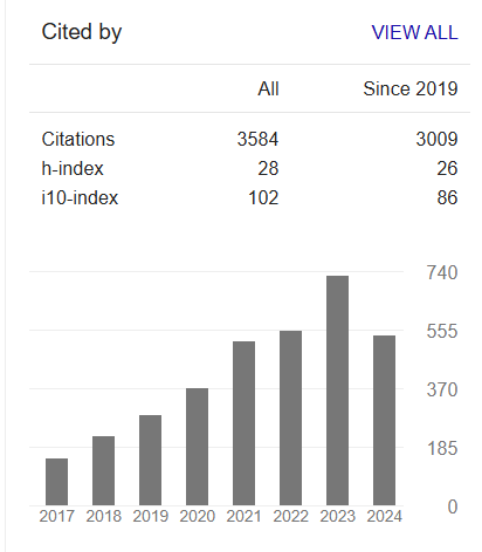Karakter Morfologi Akar dan Hasil Padi Ratun (Oryza sativa L.) pada Perbedaan Waktu dan Tinggi Pemotongan Tunggul Sisa Panen
Ananta Bayu Pratama(1*), Didik Indradewa(2), Erlina Ambarwati(3)
(1) Departemen Budidaya Pertanian, Fakultas Pertanian, Universitas Gadjah Mada
(2) Departemen Budidaya Pertanian, Fakultas Pertanian, Universitas Gadjah Mada
(3) Departemen Budidaya Pertanian, Fakultas Pertanian, Universitas Gadjah Mada
(*) Corresponding Author
Abstract
Penelitian ini bertujuan untuk menentukan waktu dan tinggi pemotongan tunggul sisa panen yang optimal untuk mendukung pertumbuhan akar sehingga diperoleh daya hasil padi ratun maksimal. Percobaan lapangan disusun dalam Rancangan Acak Lengkap split plot 2 faktor dan 3 blok sebagai ulangan. Percobaan lapangan disusun dalam Rancangan Acak Kelompok Lengkap split plot 2 faktor dan 3 blok sebagai ulangan. Petak utama berupa waktu pemotongan tunggul, terdiri dari 3 taraf yaitu: saat panen (0 HSP), 7 hari setelah panen (7 HSP) dan 14 hari setelah panen (14 HSP). Anak petak berupa tinggi pemotongan tunggul, terdiri dari 4 taraf yaitu: 4 cm, 14 cm, 24 cm dan 34 cm. Variabel yang diamati berupa variabel morfologi akar dan hasil padi ratun. Data yang diperoleh dianalisis varians (ANOVA) dengan taraf kepercayaan 95%, dilanjutkan dengan uji polinomial orthogonal. Hubungan antar variabel pengamatan ditentukan dengan analisis korelasi. Hasil penelitian memberi informasi bahwa waktu pemotongan tunggul sisa panen hanya berpengaruh nyata terhadap diameter akar dengan waktu pemotongan terbaik 10 HSP yang menghasilkan diameter terbesar 0,89 mm, ketika dilakukan pemotongan tunggul setinggi 4 cm di atas permukaan tanah, namun tidak berpengaruh nyata terhadap sifat perakaran lainnya. Fase vegetatif yang paling lama (44 hari) dan produktivitas gabah yang paling tinggi (3,39 – 3,54 ton/ha) diperoleh bila tunggul dipotong setinggi 4 cm di atas permukaan tanah, namun perbedaan waktu pemotongan tunggul tidak berpengaruh nyata terhadap kedua variabel tersebut.
Keywords
Full Text:
PDFReferences
Abdulrachman, S., E. Suhartatik, Erdiman, Susilawati, Z. Zaini, A. Jamil, M. J. Mejaya, P. Sasmita, B. Abdulah, Suwarno, Y. Baliadi, A. Dhalimi, Sujinah, Suharma dan E. S. Ningrum. 2015. Panduan Teknologi Budidaya Padi Salibu. . Diakses pada 21 Agustus 2016.
Azura, A. E., J. Shamshuddin dan C. I. Fauziah. 2011. Root elongation, root surface area and organic acid by rice seedling under Al3+ and/or H+ stress. American Journal of Agricultural and Biological Sciences 6: 324-331.
Bertrand-Morvan, A., J. Boucaud and M. Prud’homme. 1999. Influents of initial levels of carbohydrates, fructans, nitrogen and soluble proteins on regrowth of Lolium perenne L. cv. Bravo following defoliation. Journal of Experimental Botany 50: 1817-1826.
Blum, A. and J. T. Ritchie. 1984. Effect of soil surface water content on shorgum root distribution in the soil. Field Crops Research 8: 169-176.
Chauhan, J. S., B. S. Vergara and F. S. S. Lopez. 1985. Rice Ratooning. IRRI, Manila.
Chiangmai, P. N. dan P. Yodmingkhwan. 2011. Competition of root and shoot growth between cultivated rice (Oryza sativa L.) and common wild rice (Oryza rufipogon Griff.) grown under different phosphorus levels. Songklanakarin Journal of Science and Technology 33: 685-692.
Corbesier, L., G. Bernier and C. Perlleux. 2002. C:N ratio increases in phloem sap during floral transition of long day plants Sinapis alba and Arabidopsis thaliana. Plant Cell Physiol 43: 684-688.
Dunand, R. and Saichuk, J. 1999. Rice Growth and Development. In: Saichuk, J. (Eds). Lousiana Rice Production Handbook. LSU Ag. Center, Lousiana. p: 34-45.
Gregory, P. J. 2006. Plant Roots: Growth, Activity and Interaction with Soils. Blackwell Publishing, Oxford.
Ichii, M. and N. Ogaya. 1985. Application of ratoon traits obtained by higher cutting for estimation of precentages of ripened grains in rice plants. Japan. J. Breed 35: 311-316.
Ichii, M. 1988. Some Factors Influencing the Growth of Rice Ratoon. In: W. H. Smith, V. Kumble and E. P. Cervantes (Eds). Rice Ratooning. International Rice Research Institute, Manila. p: 41-46.
Kitomi, Y., H. Kitano and Y. Inukai. 2011. Moleculer mechanism of crown root initiation and the different mechanisms between crown root and radicle in rice. Plant Signal Behavior 6:1270-1278.
Makarim, A.K. and E. Suhartatik. 2006. Morfologi dan Fisiologi Tanaman Padi. Balai Besar Penelitian Padi, Subang.
Morita, S. dan J. Abe. 1994. Modelling Root System Morphology in Rice. In: Davis, T. D. dan B. E. Haissig (Eds). Biology of Adventitous Root Formation. Plenum Press, New York.
Morita, S., dan K. Nemoto. 1995. Morphology and Anatomy of Rice Roots with Special Reference to Coordination in Organo- and Histogenesis. In: Baluska, F., M. Ciamporova, S.A. Gasparikova dan O. Barlow (Eds). Structure and Function or Roots. Kluwer Academic Publisher, Massachusetts.
Nainggolan, K., I. M. Harahap dan Erdiman. 2013. Teknologi Melipatgandakan Produksi Padi Nasional. Grasindo, Jakarta.
Oad, F. C., P. S. Cruz, N. Nemon, N. L. Oad and Z. U. Hassan. 2002. Rice ratoon management. Journal of Applied Sciences 2: 29-35.
Schneider, H. M., J. A. Postma, T. Wojciechowski, C. Kuppe and J. P. Lynch. 2017. Root cortical senescence improves growth under suboptimal availability of N, P and K. Plant Physiology 174: 2333-2347.
Schneider, H. M. and J. P. Lynch. 2018. Functional implications of root cortical senescence for soil resource capture. Plant Soil 423: 13-26.
Slaton, N. A., C. A. Beyrouty, W. R. Wells, R. J., Norman and E. E. Gbur. 1990. Root growth and distribution of two short-season rice genotypes. Plant and Soil 121: 269-278.
Vergara, B. S. dan T. T. Chang. 1985. The Flowering Response of the Rice Plant to the Photoperiod. IRRI, Manila
Article Metrics
Refbacks
- There are currently no refbacks.
Copyright (c) 2018 Vegetalika

This work is licensed under a Creative Commons Attribution-ShareAlike 4.0 International License.
VEGETALIKA journal indexed by:






